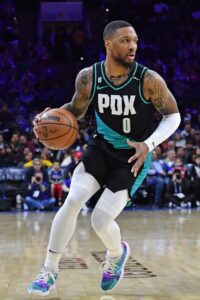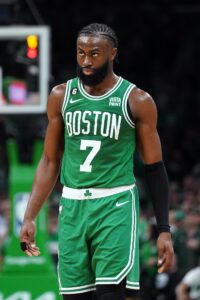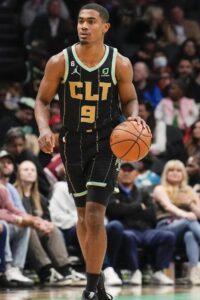With two months to go until NBA teams report to training camps, there’s no need for a club to have its 21-man offseason roster – let alone its 15-man standard roster for the regular season – set in stone at this point.
Still, many rosters around the league are clearly taking shape, with several teams carrying 14 or 15 players on standard guaranteed contracts and seemingly unlikely to make any more major changes this offseason.
There are also a handful of teams carrying more than 15 standard contracts who will have to trade or waive at least one or two of those players before the regular season begins in order to adhere to the NBA’s regular season roster limit.
Here are some of the teams who will be facing possible roster crunches in the coming months:
Oklahoma City Thunder
(20 standard contracts)
The Thunder have been a willing trade partner for teams looking to dump unwanted contracts this offseason, and it has resulted in Oklahoma City becoming the first club to reach its full 21-man roster limit (its 21st player, Keyontae Johnson, is on a two-way contract).
Of the Thunder’s 20 players on standard deals, at least 17 have guaranteed salaries for 2023/24. That group doesn’t include Jack White, whose full contract details have yet to be reported, or Isaiah Joe and Aaron Wiggins, both of whom are on non-guaranteed contracts after playing well in rotation roles in ’22/23.
If the Thunder intend to keep White, Joe, and Wiggins into the regular season, they’ll have to trade or waive five players on guaranteed salaries. The players recently acquired in those salary-dump deals – including Victor Oladipo, Davis Bertans, TyTy Washington, and Usman Garuba – would probably be most at risk. Of the Thunder’s returning players, Tre Mann and Jeremiah Robinson-Earl are among those whose roster spots may not be fully secure.
Memphis Grizzlies
(17 standard contracts)
Like the Thunder, the Grizzlies took on some unwanted contracts in offseason trades in order to acquire other assets.
The two players Memphis received in those deals – Josh Christopher and Isaiah Todd – are the most likely odd men out for the 15-man regular season roster, since none of Memphis’ other 15 players are obvious trade or release candidates.
San Antonio Spurs
(17 standard contracts)
The Spurs actually only have 16 players on standard contracts for the time being, but are reportedly bringing back Sandro Mamukelashvili on a one-year deal. He has yet to officially re-sign and the exact details of his contract are unclear.
Assuming San Antonio plans to have Mamukelashvili on its 15-man regular season roster, the team will need to trade or waive two other players before opening night. That number could grow if the Spurs want to sign Dominick Barlow or Sidy Cissoko to a standard contract, but they do have two-way slots available for both.
Cameron Payne, Cedi Osman, Reggie Bullock, Devonte’ Graham, and Khem Birch are a few of the veterans on expiring or pseusdo-expiring contracts who probably aren’t in the Spurs’ long-term plans. But some of those guys would be useful contributors on the court this season and might have a little trade value, so San Antonio might not be done dealing.
Washington Wizards
(16 standard contracts)
The Wizards have a new front office in place for this season, so some of the reserves on expiring contracts who were brought in by the old regime could be candidates to be traded or waived. That group includes Delon Wright, whose name has come up in trade rumors this summer, Xavier Cooks, whose multiyear deal is only guaranteed for 2023/24, and Anthony Gill.
The new regime has also acquired a few players this offseason who may have been traded for financial or salary-matching reasons more than for how they fit into the Wizards’ plans going forward. Of those players, Danilo Gallinari and Mike Muscala are on expiring contracts, while Patrick Baldwin and Landry Shamet aren’t currently owed guaranteed money beyond 2023/24 (Ryan Rollins has a $600K partial guarantee in ’24/25).
It wouldn’t shock me if the Wizards end up moving off multiple players on the current roster and making another addition or two before the regular season begins.
Others to watch
The Hawks are currently carrying 16 players on standard contracts, but only 15 are guaranteed, making Vit Krejci and his non-guaranteed salary the probable odd man out. Atlanta also reportedly remains active in trade talks, which could further shake up the roster.
The Hornets only have 12 players on guaranteed salaries, but they also have a pair (JT Thor and Kobi Simmons) on non-guaranteed deals, plus a pair of restricted free agents (P.J. Washington and Theo Maledon) and a No. 31 overall pick (James Nnaji) who remain unsigned. Charlotte can comfortably manage the 15-man limit, especially if Nnaji spends the season overseas, but may have to deal with a minor roster crunch if Washington and Maledon both return.
The Clippers, like the Hawks, have 15 players on guaranteed salaries and a 16th (Jason Preston) on a non-guaranteed deal. Los Angeles pushed back Preston’s guarantee date, which suggests the team may be open to hanging onto him if a roster spot becomes available (perhaps in multi-player James Harden trade?).
The Trail Blazers and Sixers are worth monitoring, since they would likely take back more players than they send out in any trade involving Damian Lillard or Harden. For now though, both teams have plenty of roster space — Portland has 13 players on standard contracts (12 fully guaranteed), while Philadelphia has 14 (13 fully guaranteed).
 Lillard and Harden asked their respective teams to move them right around the start of free agency, but nearly three weeks later, it doesn’t appear that there’s been a whole lot of movement on either front.
Lillard and Harden asked their respective teams to move them right around the start of free agency, but nearly three weeks later, it doesn’t appear that there’s been a whole lot of movement on either front. When superstars like
When superstars like 